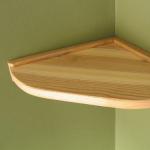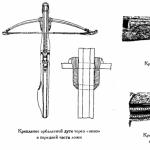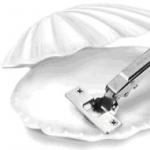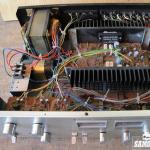This article is a step-by-step instruction on how to insert a lock into interior doors with your own hands. Here, ZAMSERVICE specialists share their skills and experience, describe in detail the installation process, and also give personal recommendations regarding the choice of a locking system. Following their advice, you can easily install the lock yourself.
If you bought an interior door without a lock or the old mechanism has run out of its resource, then it's time to get acquainted with the nuances of installing a new product. Ease of installation directly depends on the modification of the selected device. The easiest way to mount latch handles is to carefully cut a hole of the desired diameter, while locks with larvae, twist locks and handles involve a more complex installation process.
For what reasons may you need an independent tie-in of the lock
Interior doors are installed in each apartment or house. They competently divide the space, serve as protection against unauthorized entry, drafts, extraneous noise, etc. By themselves, door leafs are not complete without a reliable locking mechanism. Many door manufacturers do not supply them with built-in locks.
If you bought an interior door without a locking system, then you can install it yourself. The main thing is to approach this issue responsibly, not to rush, to act carefully and consistently.
Another reason to embed the lock in the door yourself is the breakdown of the old device. This can happen due to the expiration of the service life, due to improper use of the lock, ignoring preventive measures, and also due to mechanical damage to the structure.
In some cases, inserting a lock with a cylinder allows you to avoid large-scale repairs in the future, since replacing the cylinder is much easier and cheaper than completely changing the locking structure. Replacing the core will also be appropriate in cases where the keys are stuck in the keyhole, as well as when they are lost or stolen.
How to choose a lock for interior doors
Before you insert a lock into interior doors, you need to purchase it. The design should be chosen based on the parameters of the door leaf, in particular, it is worthwhile to pre-measure it. If the width of the vertical bar of the door is less than 4 cm, then inserting the lock is not only a pointless exercise, but also almost impossible.

In this case, door latches are more suitable, which are quite simply mounted and are the easiest way to lock doors. In addition, the choice of such structures is more than diverse. The modern market offers products of various sizes, types of installation, color and design solutions.
If higher security requirements are put forward for doors, and their width exceeds 4 cm, then mortise locks for interior doors of any well-known brand will do. They are available in a wide range, ranging from standard models to multifunctional designs complete with door handles. The appearance of the product is also important, so the locking mechanism, or rather its external parts, must be in harmony with the color and design of the door.
Correct marking - high-quality lock tie-in
The installation of any lock always begins with a markup. It is very important to avoid mistakes at this stage, since incorrect measurements lead to incorrect formation of the seat, which in the future will necessarily affect the quality of installation work. As a rule, the consequence of illiterate markup is a skewed structure. That is why you should mark the contours as accurately and accurately as possible.
Many manufacturers of high-quality fittings and locks and hardware products complete products with special templates for marking. This greatly simplifies the process and guarantees the accuracy of the location of the lock on the door leaf. If there are no such blanks in the package, then you will have to make the markup yourself by attaching the structure to the door and circling its contours with a pencil or any other writing instrument (felt-tip pen, pen, marker, chalk, etc.)

Before picking up tools for drilling holes and forming seats, you need to double-check the correct marking several times. This will ensure reliable operation of the mechanism and eliminate the formation of distortions.
Step-by-step instructions for installing a lock
So, a suitable design was found and bought in a store, so it's time to start cutting the lock. To do this, you must perform a series of sequential steps:
- Marking the location of the lock on the door (usually 1 meter from the floor).
- Drilling a hole with a drill for inserting a lock (the diameter of the feather drill should be equal to the thickness of the lock, and the depth of the drilled hole should match the length of the lock structure).
- Marking on the door leaf of the contour of the base plate.
- Carefully drilling a hole for the handle (the drill must go through the door).
- Marking the hole for self-tapping screws (attaching the structure to the intended seat).
- Drilling a hole for attaching the lock to the door leaf (according to the received markings).
- Installation of decorative overlays.
- Fixing the rod connecting the door handles.
- Closing the doors and marking the location of the tongue on the door jamb.
- Applying the receiving pad to the intended place and tracing its contour with a simple pencil.
- Measuring the length of the lock tongue and transferring it to the door jamb.
- Attaching the lining to the seat with self-tapping screws.
- Checking the performance of the device (adjusting or reinstalling the tongue if necessary).
As a rule, the above instructions are suitable for all types of interior doors, including particle board, natural wood and plastic panels (in this case, you need to buy special locks designed for PVC products).
Features of mortise locks for various types of doors
Before you insert a lock into an MDF door, you need to accurately measure 1 meter from the floor, since it is at this height that an additional wooden beam is located, and the rest of the door is hollow. Ignoring this recommendation, you can ruin the door leaf, and hopelessly. If you have any difficulties with the installation process, it is better to immediately contact the experts. The master will embed the lock with skill, while the door will retain its presentability and functionality.

Metal doors for installation inside apartments and houses are used very rarely, however, if you have just such a variant of the door leaf, then it is more expedient to use the services of professionals. In addition to the fact that such doors require a special type of lock, the process itself is also particularly difficult.
Interior doors made of plastic are quite common in modern interiors. You can embed a lock in such doors with the same ease as in wooden ones. The only thing is that the lock itself must be designed for use in PVC products. Otherwise, the advice of experts on installing locking systems in interior units is almost identical to the above instructions.
What tools are needed to cut a lock
You can install a lock on interior doors using simple tools that every home master has. You will need:
- Hand drill with drill bits
- Chisel.
- Screwdriver.
- Screwdrivers (Phillips and flat).
- Joiner's square.
- Hammer.
- Roulette (ruler).
- Pencil (pen, thin marker, felt-tip pen, chalk).
So, we figured out what tools are needed to install standard locks in interior doors. This list may vary depending on the complexity of the work, the type of door or mechanism device. Some devices can be replaced with analogues. For example, instead of a chisel, you can use a chisel, and self-tapping screws are easily screwed in with a drill.
And yet, not all types of locks can be inserted using improvised tools. In some cases, you may need a milling cutter - a special device for door blocks that provides high accuracy of the seating recesses. The milling machine is quite compact and easy to use. With it, you can cut a groove of any shape and size, give the edges of the workpiece the correct shape, prepare niches for hinges and seats for locking mechanisms.
Cutting a lock with a milling cutter
If you have a milling machine at your disposal, then the task of installing a lock in interior doors is noticeably simplified. Inserting the lock with a milling cutter is performed in the vertical position of the door on its side, which is achieved by fixing it with a slipway. This avoids the need to constantly support the canvas with your hands.

Having fixed the position of the doors, we proceed to the implementation of the insert of the lock:
- We mark the seat of the lock body and tongue.
- We cut out a recess for the locking device with a manual milling cutter.
- We insert into the machine a cutter corresponding to the size of the bar.
- Set the required depth.
- We make a hole in the center.
- We are preparing a seat for the body.
- Align its edges with a chisel.
- We carry out the insert of the lock according to the above instructions.
A milling cutter is not a mandatory tool for installing locking mechanisms, however, it is almost impossible to cut some types of locks without it. This applies to latch locks, for the installation of which it is necessary to prepare a neat hole for the keyhole. Inserting a lock without a cutter in the case of standard devices for interior doors is quite possible if all the necessary tools are at hand.
In addition to the step-by-step instructions for inserting locks into interior doors, each master has his own secrets that allow you to perform the installation as efficiently and quickly as possible:
- In order not to cut off extra millimeters with a router, the contours of the external marking can be limited with a masking tape.
- Drilling through doors can damage the door leaf, so you can split this step into two steps. First you need to drill the door on one side, continuing drilling until the tip of the drill appears on the back side. Then perform similar actions on the other side of the doors, using the resulting hole as the center.
- To hide the lock well in the hole, its depth should be 2-3 mm more than the width of the lock case.
- If the lock is mounted correctly, then the door will unlock / lock without jamming and extra diligence. Otherwise it is necessary to change the location of the counter plate.
- If you don’t have suitable tools for installing locks, and you are going to buy them, then pay attention to special kits for tapping locking mechanisms. In such kits, drills and crowns are provided that are exactly the right size.
- Immediately before fixing the lock to the door with self-tapping screws, it is recommended to make sure that it is working. Try to repeat several cycles of unlocking / locking the lock with a key and make sure that the mechanism works properly.
Of course, you can embed the lock in the door yourself, but if you are not confident in your own abilities and experience, then do not risk the doors and order the installation in a professional service. Masters will come to your home and embed the device quickly and efficiently.
If wooden doors and MDF sheets are easily filed and drilled, then it is not so easy to install a mechanism in metal and plastic blocks. Therefore, in these cases it is also better to turn to specialists.
The correct installation of an interior lock, with certain abilities and tools, can be done independently. To do this, we recommend doing the following:
- Step 1. Carefully select a lock according to the thickness of the door leaf and the characteristics of the material from which the door is made.
- Step 2. Make the necessary outlines with a pencil in the side end, along which the groove will be excavated to install the locking mechanism.
- Step 3. Using a wood crown or a drill with a chisel, create the necessary niche.
- Step 4. Using a ruler (roulette), calculate the location of the handles that will be fixed on a special pin passing through the locking device.
- Step 5. Drill holes for handles. Use your forehead to cut out the keyhole hole.
- Step 6. Make a markup and subsequent recess to install the counterpart.
- Step 7. Secure the handles, locking mechanism and counterpart with self-tapping screws and bolts.
- Step 8. Check the operation of the lock first with the door open and then with the door closed.
If you doubt your own abilities, we will install and select any locks for interior doors of any type! Over 10 years of experience! The cost of our services is from 990 rubles.
Video instruction with our specialists
A small video with the participation of our masters, where they clearly show how to properly install the lock on the interior door
We carry out insertion of interroom locks on the following conditions:
- We achieve consistently brilliant results;
- Let's carry out installation in any time, convenient for the customer, without restrictions;
- We provide guarantees for our work;
- We work with any types of locking systems, including the installation of such a locking device as a magnetic interior lock
If necessary, we will competently select any locks for interior doors, taking into account the characteristics of the door leaf and the practical needs of the customer.
Do not trust outside masters because:

- Without having at your disposal tools and practical skills developed by many years of practice, you can easily damage the door leaf;
- The absence of guarantees will not allow you to claim free repairs in the event of a subsequent breakdown of the installed lock;
- The waiting time for the master from the outside can be a serious test of your patience.
Proper installation of an interior lock is a guarantee of the long-term functionality of a door system equipped with locking mechanisms in accordance with current rules and standards. The professional insertion of interior locks offered by our company is the perfect balance of efficiency, accuracy and efficiency.
Insertion of the lock is a responsible and rather labor-intensive event. It is in the final stages of renovation. The whole process can be left to professionals in the workshop, or you can do the insert yourself. To do this, you need to acquire a set of carpentry tools, since it will be impossible to insert a lock into an interior door without them.
Choosing the right lock
To choose a suitable lock for an interior door, you must clearly define the requirements for it. The emphasis in the selection is on:- quality;
- unique design;
- color;
- noiselessness;
- key lock;
- latch functionality.
For an interior door, a handle is necessary, but a lock is not always. According to this principle, the product is selected. For a bathroom and a bathroom, a lock is required, and for a bedroom, an ordinary latch is enough. There are 3 types of mortise locks:
- WC type. Such a lock allows the user to close it from one side only, without using a key.
- Patent-type. The most popular type of lock. Allows you to close the door with a key suitable for all locks of a certain model of the product.
- Yale type. Equipped with a eurocylinder system, the uniqueness of the key depends on the secrecy of the lock. Install such products in the door of a room to which access is limited, for example, in an office.
- Handle lock. This type of lock does not restrict access, it only makes it possible to tightly close the door.
Advice! If there are small children in the house, install locks with a child-proof function or a closing lock.
Naturally, you can combine some requirements, but when you go to the store for a product, you should have a rough idea of how it will look like. The color of the lock is selected to match the tone of the door or, conversely, so that it contrasts against its background.
When buying a lock, you should pay special attention to the appearance of the product. Any scratch or dent is a sign of mechanical damage. You always have the right to refuse such an item before purchase. Carefully study all moving mechanisms. The springs must return the tongue and the handle of the lock to the starting position without delay. Check the build quality: when the handle is turned, the tongue should be completely hidden inside the product. If this procedure is not followed, you will not be able to open the door. Also make sure your door leaf matches the thickness of the structure. And try to open / close the lock several times (if any) make sure that it works without unnecessary squeaks and crackles.
Required Tools
For inserting a lock, there is a special device that not only makes a through hole in the canvas for installing a handle, but also cuts out a “pocket” into which the core of the lock is inserted. When installing the door with your own hands, the tie-in is carried out using the following tools:- drill;
- a set of drills for wood;
- hammer;
- a set of chisels;
- pencil;
- measuring tape;
- carpentry knife.
Important! When drilling holes, observe safety precautions. When working, do not neglect goggles and a mask that protects the respiratory tract.
All tools must be in good working order. Knives and chisels are sharpened. If the tools do not work correctly, you will not only not be able to install the lock, but also ruin the canvas.

Locks, regardless of their type, are mounted almost the same, the only difference is the handle-type lock, its insertion is easier and faster.
Drilling a landing hole
Work on the installation of locks in door leafs is carried out at the final stage of finishing work in the room. No matter how you cover the installed handles and locks with plastic wrap, they will still be dirty or damaged. If the door is installed, and repairs are ongoing in the room, it is best to screw a self-tapping screw into the lock installation site, it will be enough to cover the door. Also, it is not necessary to fasten the platbands to the door frame before inserting the lock, the canvas is removed from the hinges, for the convenience of work, and they can prevent this.In order to properly embed the lock into the interior door, it is necessary to make accurate markings. The product is installed at a distance of 80-90 cm from the bottom of the door leaf. Measure the required distance with a tape measure and mark the insertion point with a pencil. Attach the lock to the end of the door and mark the length of the hole.
Advice. When marking, make a small margin so that the product easily enters the hole.
It is necessary to draw a line that runs along the center of the end of the door leaf. It will be the basis for cutting out the seat for the castle.
For the convenience of carrying out the work, it is necessary to remove the door from the hinges, if it is installed in the door frame, and put the hinges to the floor. Place the canvas in such a way that it can be approached from any direction.

Drilling a "pocket" for the lock is the most important step in the process of installing the product.
- Install a drill with a diameter corresponding to the width of the lock (1.2 mm) on the drill.
- Drill a hole (0.5 cm) at the intersection of the center line of the butt and the bottom mark for the location of the lock.
- Move the drill 7-8 mm higher and make another hole of the same depth.
- Continue to make holes in increments of 7-8 mm to the top mark for the location of the lock.
- Go back to the bottom mark and on the hole that left sharper than the drill, cut another 0.5 cm in depth. So continue to move carefully until you get an oval groove with a depth corresponding to the dimensions of the lock.
- Check how freely the lock enters the resulting hole.
Important! Do not rush to drill the entire depth at once, a hole made in small steps will be neater.
Installing the lock pad
When inserting a lock with their own hands, some craftsmen install a lock pad on top of the door leaf, so when the door fits snugly against the opening, it clings. To prevent this from happening, the lining is recessed into the canvas exactly to its width, compared with the surface of the door.Lock insertion is an engineering process, so each stage needs detailed marking. Insert the lock into the drilled hole and make a mark around the perimeter of the entire plank. Make notches with a chisel along the edges of the intended place for the lining. And carefully remove the inner part, lightly tapping the chisel with a hammer.
Advice. Work with the utmost care so as not to chip the canvas. And do not drown the lock deep into the door leaf.
Hole for handle and lock core
After the above procedures, you can start drilling holes for installing the lock core and handles. Here the work is faster and easier. You need to drill 2 through holes - one for the handle, the other for the lock core.
But do not forget about the markup: here it must be done, taking into account the design of the lock and the drilling process. Please note that drilling must be done very carefully so that the pen does not break through at the exit, but drills through the front of the web. It is best to refuse to drill through and make 2 marks on both sides of the door, then drill one hole and the second on the other side.
Important! Make the marks for the holes as accurately as possible; if they do not match, further insertion will be impossible.
The main snag at this stage of the work on the lock insert is drilling a hole for the core of the lock. To make a hole of the desired shape, you will need to work with a jigsaw or chisel.
The process of assembling and installing the lock
The final stage of the work being done is the assembly and final installation of the lock in the prepared place. Here it is very important to follow the sequence of certain actions:- Insert the lock into the prepared "pocket" that was cut in the center of the end of the canvas.
- Fix the product with two self-tapping screws on the top and bottom of the decorative strip.
- Install the core and attach it from the end by screwing in a long bolt. To install correctly, you must insert the key into it with the tongue down. Try to close and open the lock, then tighten the fastener (bolt) in the closed position.
- Insert the handle fastening pin into the corresponding hole, fix both handles on both sides of the door with self-tapping screws or ties.

The lock is embedded and ready for use. If you have done all the work correctly, then the product will serve you flawlessly for more than one year, and you will not be tormented by the problem of “how to insert a lock into an interior door” for a long time. You can easily do it yourself. The video describes in detail all the points of the frame and shows the process in action.
How to embed a door lock with your own hands: video
Reading time ≈ 3 minutes
Installing a lock mechanism in an interior door allows you to increase the comfort of living. To carry out the installation, you need a small number of tools: a drill, a screwdriver. Any homeowner can do the job. It takes about 15-30 minutes to insert a lock into an interior door with your own hands.
What tools are needed to install the lock?
The accuracy of installing the lock in the interior door depends on the correct preparation, the tools and components used. The use of amateur or professional equipment will increase the reliability of performance and simplify the installation procedure. To work, the owner will need:
- set of handles and lock mechanism;
- chisel;
- self-tapping screws (included) and a screwdriver;
- feather drill for wood 23 mm;
- drill and crown cutter for wood (diameter 5 cm).
In the absence of tools, it is recommended to take them from friends or neighbors. Carefully carry out work without the use of auxiliary equipment will not work. To learn how to embed a lock in an interior door, a detailed study of photo instructions and tips from the masters will help.
Step-by-step instructions for installing a lock on an interior door
After purchasing the kit, preparing the tools, you can immediately get to work. Additionally, it is recommended to study the requirements and recommendations of the lock manufacturer. Direct insertion of the lock is carried out according to the following instructions:
1. 95 cm are measured from the bottom of the canvas, 6 cm are measured from the edge. The intersection point is marked with a pencil on the canvas itself.


2. The mark from the canvas is transferred to the center of the end part (using a square).


3. At the point marked on the end, using a drill pen and a drill, a hole is drilled for the locking mechanism.


4. On the canvas, using a crown cutter, a hole for the handles is prepared at the previously set mark.




5. A locking mechanism is inserted into the hole prepared at the end of the door, circled around the perimeter with a pencil, and removed from the hole.


6. Using a chisel in the end part, a section for the lock is prepared (along the marked perimeter of the outer part of the mechanism). The thickness of the cut-out area should be equal to the thickness of the latch of the lock (approximately 0.5 cm).



7. The lock is installed and fixed in the prepared hole using self-tapping screws.


8. Install the handle with screws first. First, the screws are unscrewed, then the handle is installed in the door.


9. The handle itself and the decorative trim are removed from the second part of the element (using the key from the kit). This procedure is well demonstrated in the attached video instruction.


10. The second part of the handle is inserted into the door, fixed with screws. A decorative overlay is installed, the handle itself. The installation work has been completed.






After completing the installation, the contractor will only have to check the operation of the elements and remove the resulting debris. In the future, it will be necessary to periodically adjust the handles (every 3-4 years) due to their loosening as a result of operation. Lubrication of the lock is carried out in case of severe jamming (dust, debris). The mechanism is disassembled and processed according to the manufacturer's instructions.
When carrying out self-assembly of the lock in the interior door, it is worth remembering to carefully drill holes and cut out the area for the latch. Drilling holes with a milling cutter must be performed on both sides of the blade. This will help to prepare the desired diameter and easily install the components. It is also important to gradually tighten the screws that fasten the handles. With strong twisting, the likelihood of too tight fit of the elements and the difficulty of opening the door increases. Compliance with these requirements will help to embed the lock without professional help.
Video of inserting a lock into an interior door with your own hands
Despite the widest range of doors , almost all of them are sold without door hinges and locks . We will tell you how to embed a lock in an interior door from DIY MDF. In our case, lever handles with a lock and a latch retainer crashed.
To embed a lock on a door, you will need the following materials:
The work begins with marking the door.
Marking the position of the lock on the interior door
The distance from the floor to the doorknob will be about a meter. A lock is applied to the door from the outside and the place is marked where the lock mechanism will be installed - there will be corresponding groove . Along its borders, mark with a pencil 2 horizontal lines and one axial line between horizontal. Also mark the width of the groove. This value is equal to the thickness of the locking mechanism. 
The next step is to select a hole for the lock.
The drawn rectangle is removed using a hand mill or chisel. You can also take advantage drill .
Having tried on the lock, the hole must be brought to the required size so that the groove matches the dimensions of the lock. 
The next step is to install the lock on the door and fix it.
Insert the lock, check the verticality of its position and mark the places for self-tapping screws, on which the front plate will be attached. Carefully drill the desired holes and tighten the screws. Make sure the lock is secure and does not wobble.

Then press the faceplate of the lock flush with the door edge. With a knife, you need to make an incision along the line of the bar, so that a trace remains from it. After that, we remove the screws, then the lock and select the canvas with a chisel along this trace to the depth of the bar. At the same time, trying on the lock, keeping an eye on the position of the level of the bar relative to the canvas - it should not go deep into the canvas, but it should not stick out either.  By the way, you can learn not only how to insert a lock into an interior door with your own hands, but also how and how to hang it correctly. All these moments are very important for the door to open and close well.
By the way, you can learn not only how to insert a lock into an interior door with your own hands, but also how and how to hang it correctly. All these moments are very important for the door to open and close well.
Installing Handles and Latch Retainer
We mark the holes for the rosettes of the handles and the latch retainer with an awl.
After that, it is necessary to drill through holes in the door with a No. 5 drill. We start drilling first from one side, and then from the second, avoiding the formation of chips. Then drill holes with a larger diameter drill. Drilled holes must be cleaned of sawdust.  Then you need to insert the lock into the door and fix the front plate with self-tapping screws. Then install the handles and clamps and fix them with self-tapping screws.
Then you need to insert the lock into the door and fix the front plate with self-tapping screws. Then install the handles and clamps and fix them with self-tapping screws. 
Next, fasten the mounting sockets of the handle with self-tapping screws. 
And install a decorative overlay. 
According to the same scheme, installed and lock knob.

Then we check how the mechanism works. 
And the last step:
Installing a striker on the door frame
To the place of the cut straps into which the tongue of the lock will go, put tape on the door. We close the door and mark the position of the tongue with a pencil. We open the door and, in accordance with the marks, mark the position of the striker.

Using a drill and a chisel, we select the material according to the marked dimensions of the plank. 
Then the bar is inserted, slightly fixed with self-tapping screws and adjusted so that the closed door is tightly fixed, with a tongue in the reciprocal plate. To do this, the bar is removed, adjusted and put in place. After that, the screws are finally twisted.
Now that you know how to embed a lock in an interior door, you can do this work yourself, and not invite craftsmen who will have to pay for this work.
(Visited 695 times, 1 visits today)


















